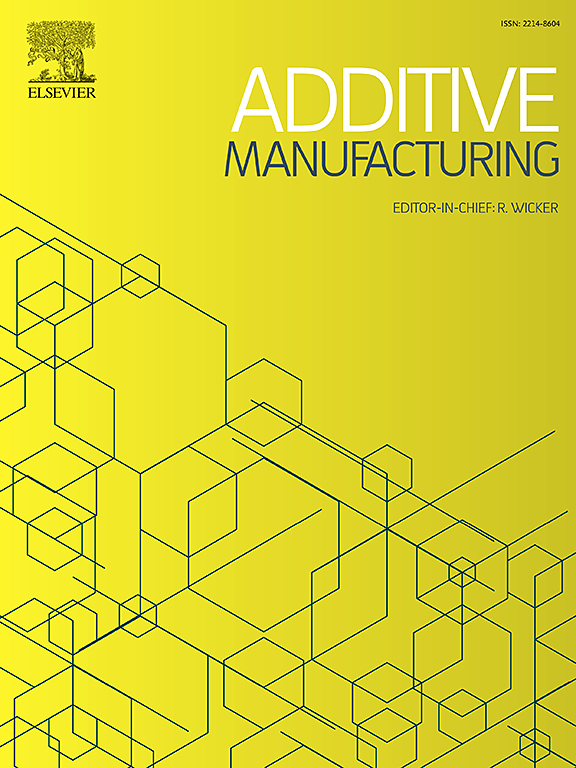Numerical and experimental investigation of laser-assisted fused filament fabrication of carbon fibre reinforced polyether-ether-ketone composites: Temperature field evolution and crystallisation behaviours
IF 10.3
1区 工程技术
Q1 ENGINEERING, MANUFACTURING
引用次数: 0
Abstract
This study presents a parameterised finite element modelling approach to predict the temperature field evolution and crystallisation behaviour of short carbon fibre reinforced polyether-ether-ketone (SCF/PEEK) during laser-assisted fused filament fabrication (LAFFF). The model innovatively integrates dynamic laser-nozzle heat sources with the melting-crystallisation kinetics of materials, which effectively addresses the longstanding issues of thermal imbalance and non-uniform crystal distribution in composites additive manufacturing. Validated through thermocouple measurements, infrared monitoring, and differential scanning calorimetry, the framework achieves predictive accuracy within ± 5 % for average relative crystallinity and ± 20 % for crystal variance. This research uncovers the crucial role of laser induced through-thickness heat transfer, a characteristic that has not been previously evident in conventional FFF. The results show that optimised auxiliary heating parameters, with ambient temperatures ranging from 75–110 °C and laser power between 2–3 W, create a process window that balances crystallinity enhancement with defect mitigation. Laser preheating generates transient temperature cycles, prolonging the exposure of the material near the crystallisation peak temperature of 235 °C. Meanwhile, elevated ambient temperatures decrease thermal gradients, together expanding the crystallisation window. This synergistic effect boosts the average relative crystallinity by 60 %–82 % compared to conventional rapid - cooling FFF, reaching values similar to those of industrial - grade 3D printing systems. These insights pave the way for the optimisation of thermal conditions in LAFFF, reducing dependence on high-temperature equipment and expanding the applicability of SCF/PEEK 3D printing technology.
激光辅助熔丝制备碳纤维增强聚醚-醚-酮复合材料的数值与实验研究:温度场演化与结晶行为
本研究提出了一种参数化有限元建模方法来预测短碳纤维增强聚醚醚酮(SCF/PEEK)在激光辅助熔丝制造(LAFFF)过程中的温度场演变和结晶行为。该模型创新地将动态激光喷嘴热源与材料的熔融结晶动力学相结合,有效地解决了复合材料增材制造中长期存在的热不平衡和晶体分布不均匀的问题。通过热电偶测量、红外监测和差示扫描量热法验证,该框架的平均相对结晶度预测精度为±5 %,晶体方差预测精度为±20 %。这项研究揭示了激光诱导的穿透厚度传热的关键作用,这一特性在传统FFF中并不明显。结果表明,优化的辅助加热参数,环境温度在75-110℃之间,激光功率在2-3 W之间,创造了一个平衡结晶度增强和缺陷缓解的工艺窗口。激光预热产生瞬态温度循环,延长了材料在235℃结晶峰值温度附近的暴露时间。同时,升高的环境温度降低了热梯度,共同扩大了结晶窗口。与传统的快速冷却FFF相比,这种协同效应使平均相对结晶度提高了60% % - 82% %,达到与工业级3D打印系统相似的值。这些见解为优化LAFFF的热条件铺平了道路,减少了对高温设备的依赖,扩大了SCF/PEEK 3D打印技术的适用性。
本文章由计算机程序翻译,如有差异,请以英文原文为准。
求助全文
约1分钟内获得全文
求助全文
来源期刊

Additive manufacturing
Materials Science-General Materials Science
CiteScore
19.80
自引率
12.70%
发文量
648
审稿时长
35 days
期刊介绍:
Additive Manufacturing stands as a peer-reviewed journal dedicated to delivering high-quality research papers and reviews in the field of additive manufacturing, serving both academia and industry leaders. The journal's objective is to recognize the innovative essence of additive manufacturing and its diverse applications, providing a comprehensive overview of current developments and future prospects.
The transformative potential of additive manufacturing technologies in product design and manufacturing is poised to disrupt traditional approaches. In response to this paradigm shift, a distinctive and comprehensive publication outlet was essential. Additive Manufacturing fulfills this need, offering a platform for engineers, materials scientists, and practitioners across academia and various industries to document and share innovations in these evolving technologies.
 求助内容:
求助内容: 应助结果提醒方式:
应助结果提醒方式:


